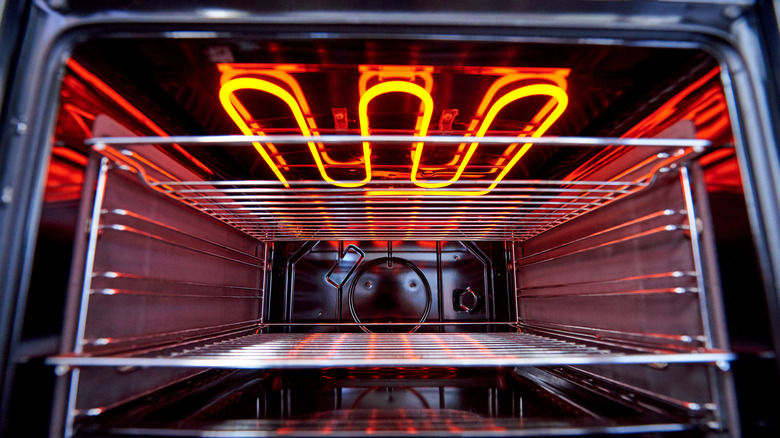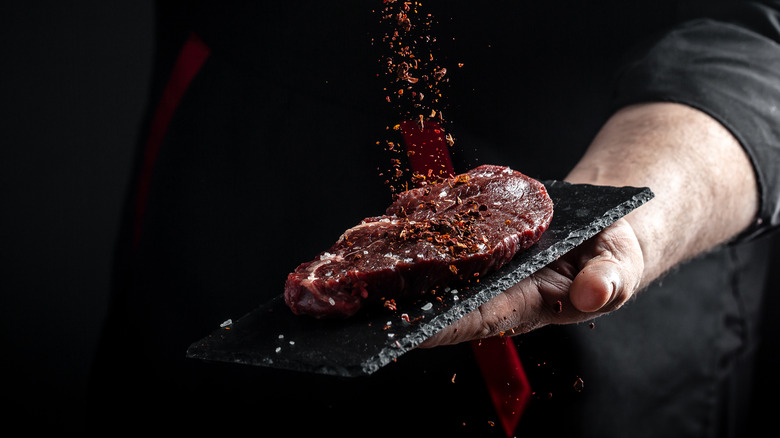Alton Brown Shares The Best Ways To Make Barbecue Without A Grill
It can be frustrating when the craving for delicious homemade barbecue hits, but there is no barbecue grill in sight. Perhaps you do not own a barbecue because you live in an apartment, a residence where it is not permitted, or perhaps the weather is just not cooperating. Whatever the reason, celebrity chef Alton Brown has tips that will allow you to emulate the desired barbecue flavoring from the confines of your kitchen — regardless of the size.
Brown's number one tip for recreating a barbecue result indoors is to use a grill pan with raised ribs. These pans offer two immediate advantages: "They make grill marks ... [And] allow fat and moisture to fall away from the surface of the food," the "Good Eats" host said in a video for Food Network. He recommends using a cast iron model, preferably with low edges that allows the food being grilled to be easily manipulated. If using a large cut of meat, Brown suggests searing on the stove top and moving it to the oven to finish cooking.
Jean-Paul Bourgeois, the executive chef at New York's Blue Smoke, echoed Brown's suggestion for creating in-kitchen barbecue. While speaking to Food & Wine, Bourgeois stressed the importance of properly seasoning a grill pan, which helps the caramelization reach the desired flavor.
Although they achieve the barbecue flavoring, grill pans are best-suited for quick recipes. But if you do not yet have access to one, there are other workarounds Brown suggests.
Use the broiler but beware
A standard oven can be a great place to drum up barbecue flavoring without an actual grill. Alton Brown suggests using the broil feature on your oven, but do not simply turn the dial to broil and expect the delicious charred taste. In his video for Food Network, the "Cutthroat Kitchen" host recommends moving the racks in your oven to the top slot. And, to truly capture that barbecue taste, he suggests putting the meat directly on the rack. Of course, to avoid a disastrous mess, Brown says to place a pan or baking tray under the meat to catch the juice and drippings.
Putting the oven to broil is a close approximation to barbecuing with one twist: The heat comes from the top instead of the bottom. While convenient for small-to-medium cuts of meat, it is not advisable to use the broil technique on any cut that requires a lengthy cook time.
Also, placing the food on the top rack and setting the oven to broil is not enough. The oven door needs to be left slightly open when broiling. This keeps the airflow circulating in the oven, otherwise the thermostat would turn the broiler off once it reaches broiling temperatures. At that point, the food is just baking in the stymied heat. To keep smoke to a minimum, be sure to trim excess fat from any meats before broiling.
Once finished cooking, there are still other steps to maximize the barbecue flavoring.
Using seasonings to achieve that smokey flavor
According to Alton Brown, replicating the barbecue flavor can be nearly achieved before the cooking process begins. In his indoor barbecue tutorial for the Food Network, the celebrity chef stressed the importance of choosing the right meats, which can have smokey flavoring, and using smoked salts and seasonings. Brown prefers Danish smoked salts and smoked paprika. He also recommends brushing liquid smoke on the meat about an hour before cooking and reapplying up to three times.
While liquid smoke can deliver the flavor and aroma of an actual grill, others warn to use it sparingly as the liquid can quickly become overpowering. Similar to Brown, chef Jean-Paul Bourgeois uses smoked paprika, along with smoked cumin and chipotle Tabasco, as he told Food & Wine.
Professor Greg Blonder, a science advisor for AmazingRibs.com, believes the best way for liquid smoke to closely resemble that charred barbecue taste is to combine it with other seasoning and sauces, which dilutes the smokey taste while enhancing a grilled barbecue flavoring.
A word of warning when using smoke-flavored seasoning indoors, as they often smoke up during cooking and can cause coughing fits, is to use them sparingly or after the cooking is finished. Sprinkle the smoked salts suggested by Brown on the meat once it has been cooked or drizzle with smoked olive oil to make that barbecue flavor prevalent.


